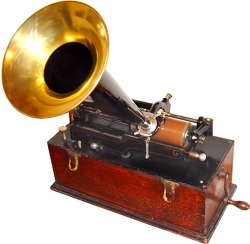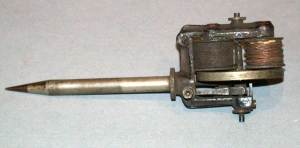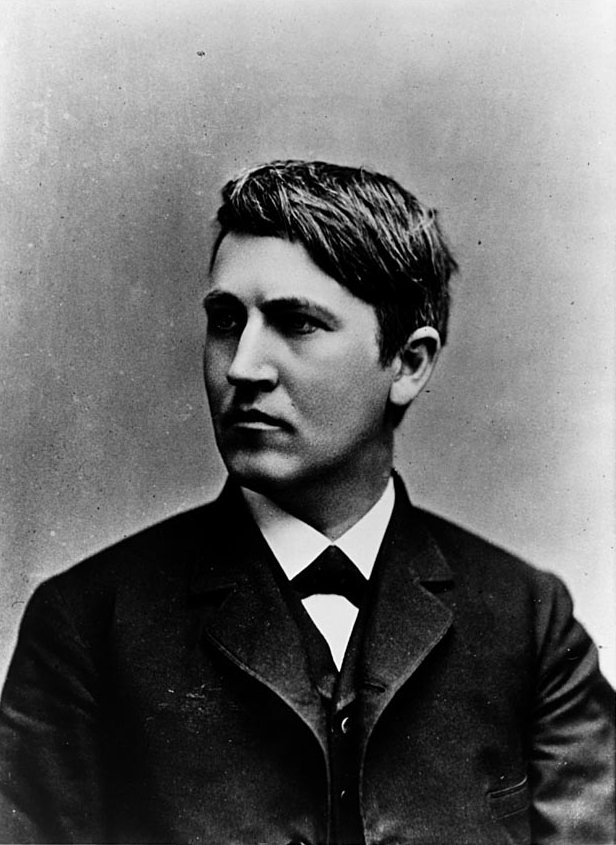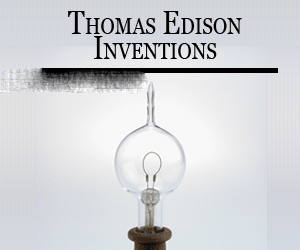Inventions Timeline

Thomas Edison Invention Timeline:
1868: He invented an automatic vote recorder for legislatures.
1869: He invented several telegraph devices.
1871: He made several improvements in stock ticker technology.
1874: He invented the quadruplex telegraph for Western Union company, which transmited four messages simultaneously (two in each direction).
1875: He invented the electric pen, an early copying device, and worked on various telegraph inventions.

1877: He invented the phonograph and the carbon transmitter (a crucial improvement in phone technology).
1879: He invented a direct current generator for incandescent electric lighting and the carbon filament lamp.
1882-1883: He designed and contracted for the first three-wire central station for distributing electric light, power, and heat
1883: He constructed the first, relatively crude, three-wire central system for electric lighting in a simple wooden structure in Sunbury, Pa.
1886: He invented an improved wax-recording phonograph called the graphophone.
1881 – 1887: He invented a system of wireless telegraphy, (by induction) to and from trains in motion, or between moving trains and railway stations. The new system was installed on the Lehigh Valleys in 1887, and was used there for many years. He invented a wireless system of communication between ships at sea, ships and shore and ships and distant points on land.
1887-1890: He made major improvements on the brown wax and black wax cylinder phonograph. He obtained over eighty related patents, while establishing a very extensive commercial business in the manufacture and sale of phonographs and records, including associated dictating machines, “shaveable” records, and shaving machines.
1891: He made a number of inventions associated with improving electric railways. He Invented and patented the motion picture camera. This mechanism, with its continuous tape-like film, made it possible to take, reproduce, and project motion pictures as seen and heard today.
1891-1900: He developed his great iron ore enterprise, in which he did some of his most brilliant engineering work. One of his most significant inventions of this period was a giant roller machine for breaking large masses of rock and finely crushing them. He invented the Fluoroscope realizing the necessity and value of a practical fluorescent screen for making examinations with X-rays, he made thousands of crystallizations of single and double chemical salts and finally discovered that crystals of Calcium Tungstate made in a particular way were highly fluorescent to the X-ray. He also made many several improvements on the X-ray tube.
1905: He invented a revolutionary new type of dictating machine, which enabled the dictator to hear repetitions and make paper scale corrections.
1907: He invented the Universal Electric Motor which made it possible to operate dictating machines on all lighting circuits.
1900 –1909: He made many important inventions relating to the processes involved in the production of pre-cast buildings.
1900 – 1910: He invented and perfected the steel alkaline storage battery and made it a commercial success
1910-1914: He invented the diamond point reproducer and the “indestructible” record, thereby commencing a new era in phonographs.
1912: He invented the Kinetophone or talking motion picture.
1913: He Invented an important automatic correction device for the dictating machine.
1914: He invented the Telescribe, combining the telephone and the dictating phonograph, thus permitting – for the first time – the recording of both sides of a telephone conversation.
1915: He invented the first synthetic form of carbolic acid (C6H6O).
A little about his life:
Thomas Edison was born to Sam and Nancy on February 11, 1847, in Milan, Ohio. He was the youngest of seven children, but unfortunately only four survived to adulthood. As a young child he did not have good health and when he was about twelve years old he almost lost his hearing. Some say it was from the aftereffects of scarlet fever.
In 1868 he worked in a Western Union Office and eventually started working on inventing things. In 1869 he resigned his job and started full time working on many inventions.
Summarized Biography Of American Scientist

Thomas Alva Edison was born on February 11, 1847 to a middle-class family.
Thomas Edison was one of the many inventors responsible for shaping our Modern World.
In 1876, Thomas Alva Edison, after being beaten by Bell to paten the telegraph, invented the Light Bulb. This marked Thomas Edison’s place on technological history forever.
In 1877, Thomas Alva Edison set-up the world’s first research and development center in West Orange, New Jersey.
In 1890, Thomas Alva Edison invented the Vita scope, which lead to the first ever silent, motion pictures.
In 1892, Thomas Alva Edison’s company Edison’s General Electric Co. merged with another firm to become the General Electric Corporation. Edison was the major stockholder of the corporation.
Thomas Alva Edison was known world-wide as the Wizard of Menlo Park, the Father of the Electrical Age,” and the Greatest Inventor Who Ever Lived.”
At 83 years old, Thomas Alva Edison finished with 1,093 patents.
Thomas Alva Edison died on October 18th, 1931, at the age of 84. He woke up from his coma, right before passing, and told his wife Mina “It is very beautiful over there…”
On the evening he was laid to rest, many corporations, communities, and individuals dimmed their lights in honor of Thomas Alva Edison.









leave a comment